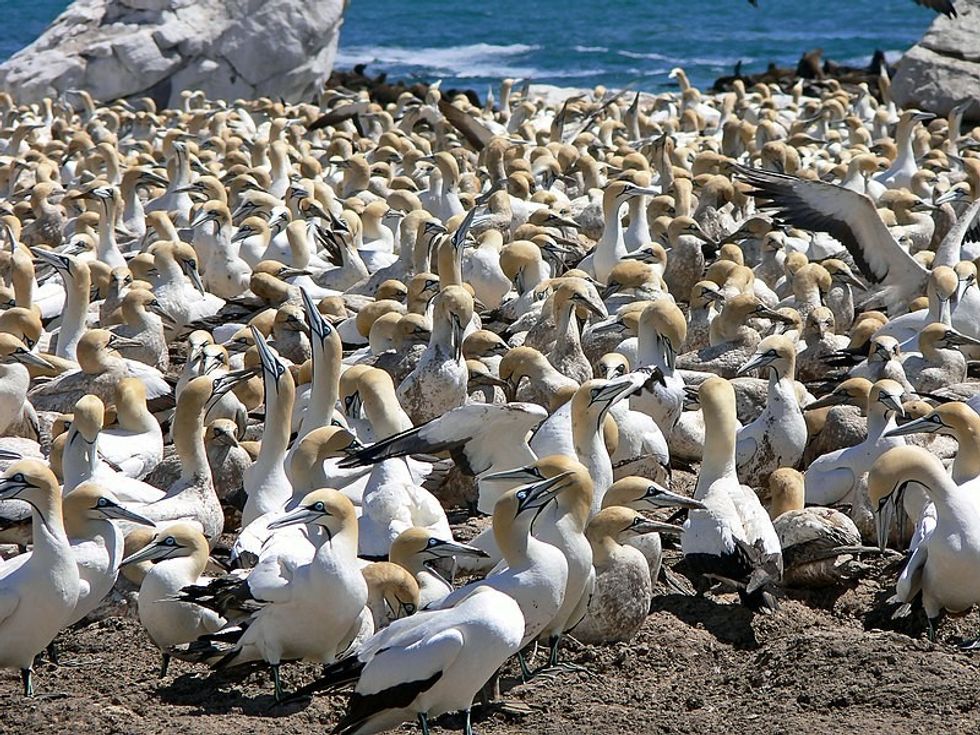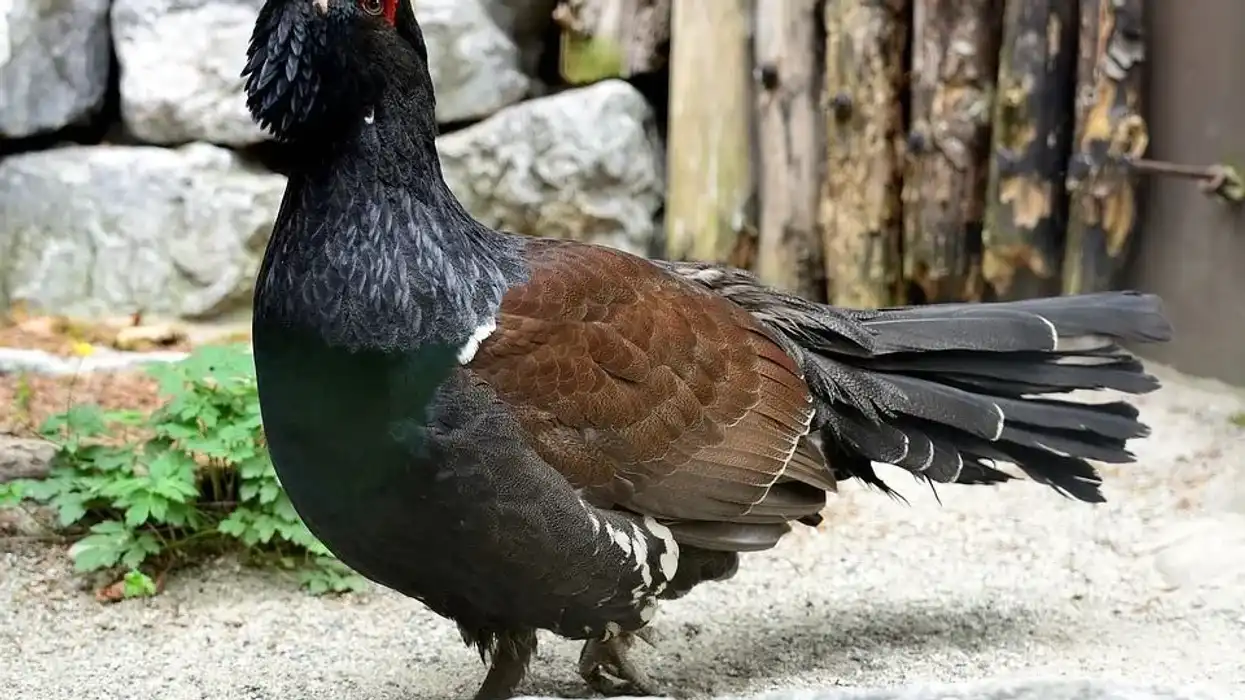Human beings have an inimitable fascination for birds. After all, who doesn't want to take flight up in the sky just like birds? Reading about these birds unveils the marvelous sides of nature. One of these species is Cape gannet, Morus capensis.
A Cape gannet is a large seabird found around the offshore waters, east coast, and west coast of Africa. More precisely, it is recorded in Malgas Island, Lambert's Bay, and Algoa Bay in South Africa and Mercy Island, Ichaboe Island, and Possession Island in Namibia. It is a fish-eating bird with black and white plumage and foot webs.
While the Cape gannets were previously called Sula capensis, they are also known as a 'mad goose'. The name 'gannet' is a synonym for 'gluttony' meaning 'habitual of eating'. The name justifies the greed of the bird.
If the uniqueness of the Cape gannets makes you interested to read more about similar species, you can read about common murre facts and sanderling facts.
Cape Gannet Interesting Facts
What type of animal is a Cape gannet?
Cape gannets are one of the South African seabirds from the family Sulidae.
What class of animal does a Cape gannet belong to?
A Cape gannet belongs to the genus Morus. It is a large seabird found in Namibia and South Africa. The bird is gregarious in nature and is found in colonies.
How many Cape gannets are there in the world?
While there are no recent records documenting the population of the birds, the Cape gannets are labeled with the conservation status of Endangered under the IUCN List. As per the census recorded in 2009, the estimated population of the species was estimated to range within 150,000 breeding pairs.
With a limited breeding population, the population range is noticed to decline.
Where does a Cape gannet live?
Cape gannets are recorded around the offshore and coastal waters around southern Africa, mainly the west coast and east coast of South Africa. More precisely, they are found around Malgas Island, Lambert's Bay, and Algoa Bay in South Africa and Mercy Island, Ichaboe Island, and Possession Island in Namibia.
What is a Cape gannet's habitat?
Cape gannets are seabirds found near islands, offshore and coastal waters. Cape gannets are restricted within the range of 62 mi (100 km) from the sea or oceanic waters.
These birds are reportedly said to have different breeding and non-breeding range. They have a restricted habitat range around the east and west coast of southern Africa including six islands of South Africa and Namibia.
Who do Cape gannets live with?
Cape gannets are gregarious species found in colonies. The largest colony of the seabird is recorded in Malgas Islands, South Africa with over 140,000 species. The breeding of Cape gannet pair is recorded to mate at breeding colonies on guano platforms while the breeding range is within 1864 mi (3,000 km) beginning from August or September.
How long does a Cape gannet live?
Cape gannets are reported to live up to 17 years.
How do they reproduce?
The breeding of a Cape gannet bird is noticed breeding in colonies on guano platforms. The breeding season commences from August or September while the breeding range of the pairs is recorded within 1864 mi (3,000 km) from the islands.
The nest is build using a few bones, droppings, vegetation, and feathers, wherein eggs are laid by the parents. The egg is recorded to be pale blue in color, covered with brown guano.
The incubation process of an egg range from 40-46 days. The eggs hatch into juveniles (chick) and grow into one-third of the size of an adult in three weeks.
The chick is looked at by its parents until it takes its first flight from its nest. Cape gannets are known to mate for life as pairs reunite during every breeding season.
What is their conservation status?
Cape gannets are categorized as Endangered under the IUCN Red List of Threatened Species.
Cape Gannet Fun Facts
What do Cape gannets look like?
Adult Cape gannets have black and white plumage over the large-size body. Cape gannet wings are white in color with dark edges, while the Cape gannet feet are webbed. The bill is pointed and pale blue in color.
Gannets use their pointed tip of the bill to catch prey easily. Also, they have external nostrils. Gannets are often confused with northern gannets, however, northern gannets have a white tail, while Cape gannets have black tails.
On the other hand, chicks have dark brown plumage which gradually turns white uniformly with their growth. These chicks have pale bill and foot webs, which often resemble dark-colored booby.
The egg of the birds is pale blue in color covered in a coating of guano, incubated in the nest. The egg hatches into a chick, which further grows into an adult.
How cute are they?
Cape gannets are extremely cute birds with their eyes and bill adding up to their cuteness. A gannet colony is another pleasure sight to behold.
How do they communicate?
Seabirds are often silent in and around the non-breeding range, unlike other gannets and boobies. These birds make harsh calls during their breeding season which often sounds like 'arrah arrah'.
How big is a Cape gannet?
Cape gannets and seabirds are 33-37 in (84-94 cm) in length, while the wingspan range from 67-73 in (171-185 cm). Cape gannets are approximately the size of a red-footed booby.
How fast can a Cape gannet fly?
Seabirds are recorded to be considerably strong fliers, while the Cape gannet flying speed remains undeciphered. They use the flap gliding technique to take a flight, which is comparatively more energy-consuming than the dynamic soaring adapted by the albatrosses.
Cape gannet diving is recorded to take place from a considerable height and are even known for their plunge-dive.
They plunge-dive in the sea and other water bodies to catch fish to cope up with their feeding habits. These birds are recorded to have a considerably high diving speed which withstands due to the air cushion present between the Cape gannet brain and skull.
How much does a Cape gannet weigh?
This seabird weighs up to 5.7 lb (2.6 kg), which is 10 times less than the weight and body size of a wandering albatross.
What are the male and female names of the species?
The Cape gannet female and male are not assigned any sex-specific names.
What would you call a baby Cape gannet?
The baby of the bird is called a chick, fledging, or nestling in general.
What do they eat?
Analyzing the feeding habits of the bird, it was studied that the bird is a carnivore, more specifically a piscivore as its diet mainly consists of fish. The diet of the bird includes fish like pilchard, shoaling-fish, mackerel, and other fish.
They also take advantage of fishing and even steal captive fish preyed on by fishing as they are greedy birds.
Are they poisonous?
Cape gannets' anatomy revealed that the birds are not poisonous nor do they seem dangerous until threatened.
Would they make a good pet?
Cape gannets are wild social birds living in the colony with their diet including fish, which are either captured via dive in the sea and other waters or stealing fish captured by humans via fishing. Thus, the bird is not ideal to be captivated or petted.
Did you know...
Cape gannets are known to be greedy birds. This bird is at risk of being Extinct as they are starving for food due to lack of fish.
Seabirds are endemic to southern Africa.
They feed on around 10.58 oz (300 g) of fish per day.
Gannets are uplifted as Endangered seabirds under the IUCN Red List of Threatened Species. These birds are starving due to a lack of food availability. Other threats to these birds are their predators, such as the great white pelican and human hunting.
A gannet is often mistaken to be a Galapagos masked booby bird due to the similarity in appearance of the birds. The gannet can be identified with a careful eye as they have black tails, crown, and line markings around its eyes.
It is noticed to have a tint of golden-brown over its head but is white if noticed from a pretty close distance.
Are gannets greedy?
Gannets are known to be greedy in nature as they adapt smart techniques to catch their prey. They also follow commercial fishing ships or individuals to catch and prey on captive fish. They dive at a considerable speed from a considerable height to prey.
What is the difference between a Cape gannet and an Australian gannet?
While Cape gannets and Australian gannets are quite similar and belong to the same class, order, and family, both are different seabirds. The Cape gannet has black tails, while the Australian gannets have tails that are black in the middle with white edges. Moreover, Cape gannets are considerably larger than Australian gannets.
Here at Kidadl, we have carefully created lots of interesting family-friendly animal facts for everyone to discover! For more relatable content, check out these Australian pelican facts and green heron facts pages.
You can even occupy yourself at home by coloring in one of our free printable Cape Gannet coloring pages.










